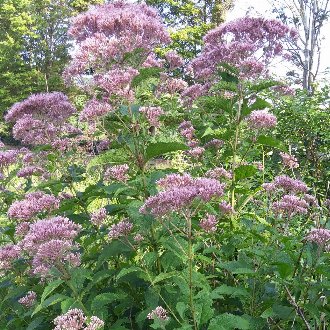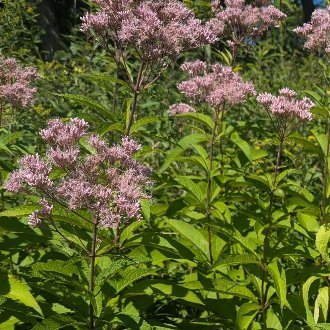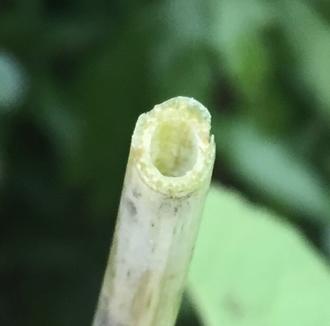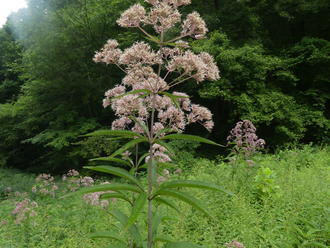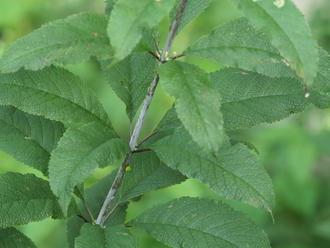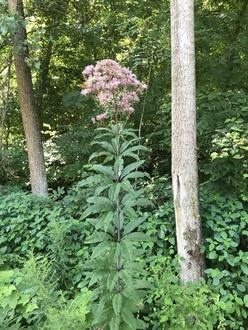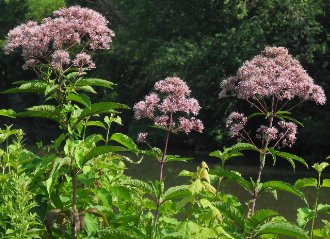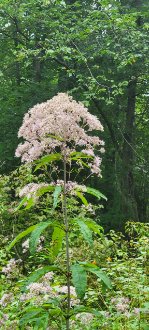Hollow Joe Pye Weed (Eutrochium fistulosum (Barratt) E.E. Lamont)
Also known as trumpetweed, hollow Joe-Pye weed, purple thoroughwort; also classified as Eupatorium fistulosum Barratt.
↑Summary
A tall perennial of moist, rich, disturbed sites, native to the eastern U.S.; the tallest Eutrochium.
↑Range - Expand
| Legend | Color |
| Native | |
| Native or Expanded | |
| Native or Not Present |
This tentative map is based on our own research. It may have limited data on Canada and/or Mexico, and there is some subjectivity in our assignment of plants as introduced vs. expanded. Read more in this blog post.
Although this plant occurs somewhere in each of these regions, it may only occur in a small part of some or all of them.
This species has recently expanded into Vermont and may be expanding elsewhere. It is widely planted and can establish from garden escapes, but its seeds may also be moved by construction equipment, and can travel long distances in the wind as well.
↑Similar Plants
↑Habitat
Found in wet, disturbed, sunny to partly wooded areas in fertile soils. Natural habitats include floodplains, swamps, wet meadows and thickets, and rocky streambanks. Also grows in many anthropogenic habitats, including wet ditches along roads and railroads or in wet areas of abandoned agricultural fields. In the west of its range, also found in wet sand prairies.
Tolerates a range of soil textures, including loam, and soils with some sand, gravel, and/or clay, but requires soils rich in both organic matter and mineral nutrients, and absent from the most acidic soils. Requires consistently moist conditions, and tolerates temporary flooding. Growth is best in sheltered sites where plants are protected from strong winds that can cause this tall, hollow-stemmed plant to fall over; such shelter results from topography, such as in ravines, and also from other vegetation such as trees far enough away not to shade the plant too much. This plant becomes less common in very flat regions.
Requires periodic disturbance to maintain the open conditions it prefers. Adapts readily to anthropogenic habitats and can be found in somewhat degraded habitats.
Prefers habitats slightly drier and more shaded than E. maculatum or E. dubium, but wetter and much sunnier than E. purpureum. Less restricted to calcareous substrates than E. maculatum. Prefers soils less acidic and more mineral-rich than E. dubium, and also less salt-tolerant and slightly less shade-tolerant than that species.
↑Life Cycle
This species is a perennial.
Seeds typically germinate in late spring or early summer. Seedlings typically require disturbance that removes competing vegetation in order to establish. Young plants often exhibit opposite leaves and much smaller leaves initially, and begin growing upright. Young plants are more vulnerable to drought or flooding and rely on luck to survive to maturity. First-year plants often flower, but when they do, flower production is small.
Established plants become more vigorous and usually reach their full height in their second year. Plants on favorable sites reproduce vegetatively by short rhizomes to form clumps with multiple stems. Established plants are more resilient, able to withstand temporarily flooding, some drought, and heavy competition from ground-level plants, as they are typically the tallest species in the habitats in which they occur.
In the absence of supporting vegetation, stems will sometimes sprawl, lean, or flop over; this usually does not harm the plant as this plant usually grows upright when faced with competition on all sides, leans when shaded on one side, or flops when exposed on all sides. Flowers appear from mid-summer to early fall, with seeds maturing in fall. Seeds are wind-distributed.
Mortality of established plants can be caused by prolonged flooding or drought, or by decrease in light levels when a canopy of trees or shrubs closes over the area.
We could not find information on this species' typical lifespan in the wild. Lifespan likely varies considerably by habitat. We also could not find information on whether this species forms a persistent seed bank.
↑Faunal Associations
The foliage, with bitter toxins, is mostly ignored by mammalian herbivores, but deer will browse it sparingly.
The flowers attract a wide variety of pollinators, including long-tongued bees, bee flies, butterflies, skippers, and moths. This plant attracts a large number of larger, showier butterflies in particular.
This species supports a number of insect herbivores, many of which eat both this species, other Eupatorieae plants, and the less-closely-related ironweeds (Vernonia sp.) which may reflect the fact that these plants often co-occur in the same habitats. The larvae of the eupatorium borer moth (Carmenta bassiformis) feed on the root of this and other Eupatorieae plants, and ironweeds. The dusky groundling (Condica vecors) and three-lined flower moth (Schinia trifascia) feed on this and other Eupatorieae plants. This and other Eutrochium sp. are also eaten by the Joe-Pye-weed borer (Papaipema eupatorii), and the red groundling moth (Perigea xanthioides) eats both this and other Eupatorieae plants as well as ironweeds. The generalist ruby tiger moth (Phragmatobia fuliginosa) also eats this plant. This plant is also eaten by the aphid Aphis vernoniae which, similarly, eats both ironweeds and Eupatorieae plants, and by the treehopper Entylia bactriana, the warty leaf beetle Exema dispar, and the skeletonizing leaf beetle Ophraella notata.
The seeds are eaten by birds, including the swamp sparrow.
↑Uses
Occasionally used in landscaping, although less commonly than other Eutrochium sp. due to its large size. However it can sometimes be valued specifically for its large size, and it is also valued for its showy flowers, whorled leaves, and attracting butterflies. It is generally easy to grow in moist, rich conditions, but it has a tendency to flop over in gardens, especially when it is not supported by other vegetation. It can be effective for creating a lush and showy planting in a wet depression where standing water accumulates for a few days after rain, especially when it is combined with other supporting plants.
This species can be used in ecological restoration projects; it is especially well-suited to riparian areas and other wet sites where the forest canopy has been removed. Its tendency to thrive in disturbed areas makes it useful in small, fragmented habitats such as ditches adjacent to paths, roads, and railroads where the vegetation can be periodically removed.
Some cultivars of other Eutrochium sp., or ones of hybrid origin, are frequently mislabeled as this species. If you want to purchase this plant and not a hybrid or other Eutrochium species, we recommend using extra caution, avoiding buying plants unless you can trust that the nursery has fully traced its origins and the original plants were rigorously identified. This issue is of particular concern with restoration plantings as the goal is usually to form a sustaining population, and hybrids or horticultural cultivars may not be as vigorous in the wild and/or may have different habitat preferences. When unsure of a plant's origin, it is better to source plants grown from seed from local populations, growing them yourself if necessary.
↑Related Plants
This species is closely related to the four other Eutrochium species, all of which overlap with it in range somewhere. It has been documented hybridizing with E. purpureum in the wild, and it may hybridize with all others as well.
↑Links & External Resources
• Eutrochium fistulosum (Hollow Joe-Pye Weed) | Illinois Wildflowers (About This Site)
• Eutrochium fistulosum (Trumpetweed) | USDA PLANTS Database (About This Site)
• Eutrochium fistulosum | Go Botany (About This Site)
• Eutrochium fistulosum (Joe-Pyeweed) | Missouri Botanical Garden Plant Finder (About This Site)
• Eutrochium fistulosum | Biota of North America Project (BONAP) (About This Site)
• Eupatorium fistulosum | NatureServe Explorer (About This Site)
• Eutrochium fistulosum | Flora of North America (About This Site)
• Eutrochium fistulosum | Missouri Plants (About This Site)
• Hollow Joe Pye Weed | Maryland Biodiversity Project (About This Site)
• Eutrochium fistulosum (Barratt) E.E. Lamont (Hollow Joe-pye-weed) | Digital Atlas of the Virginia Flora (About This Site)




